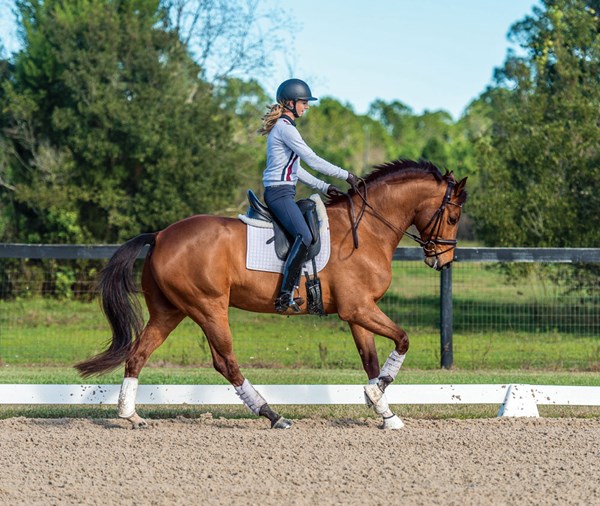
Riding a self-going horse—one who’s responsive to your lightest aids—is a magical feeling. He creates all the power necessary to produce brilliant movements, allowing you to simply sit quietly and enjoy the ride. | Amy K. Dragoo
You are working harder than your horse!” Does this sound familiar? I’ve heard riders say it to friends and peers at competitions, clinics and more lessons than I can count. This is not a compliment. Unfortunately, many riders believe that dressage requires tremendous physical effort to make the horse perform. Not true. It’s the horse’s job to produce energy. As riders, in an ideal world, we are simply able to direct that energy.
A horse can be in front of the leg and what I call “self-going”—receptive and responsive to light aids and able to maintain the gait without constant rider input—at any level. When you watch a Grand Prix horse performing a transition from passage to extended trot and back to passage, that’s the same skill that a lower-level horse demonstrates when making a transition smoothly from medium walk to free walk and back to medium walk.
Riding a self-going horse feels magical. He’s physically engaged and ready to respond to every aid. You have all the controls you need to move him forward and back and keep his body straight, which enables him to push equally off the ground with all four legs and thus produce more balanced movement. The more control you have over his body, the more effectively you can communicate with him and the quieter you can be in your own body. Nothing disrupts your position. It’s easy to sit comfortably and beautifully in the saddle.
A physically engaged horse is also much easier to engage mentally, which helps to eliminate common behavioral avoidances of work, such as spooking, bucking and rearing. A self-going horse is less spooky because he is focusing on you and the task at hand rather than worrying about what is on the other side of the arena. Sometimes an honest spook is unavoidable, but the more physically and mentally engaged a horse is, the less this will be a problem.
I have vivid flashbacks of learning the self-going lesson the hard way while training my first dressage horse, a Quarter Horse named Sunny, in Vermont. I remember riding him on 20-degree winter days in a tank top, sweating bullets. After years of riding this way, I met a trainer who taught me how to get a horse in front of my leg for the first time. Sunny is now 22 and is in the best shape of his life thanks to the benefits of my learning this lesson. He helped me discover skills that have benefited every horse I’ve ridden since then.
Riding a horse who is behind your leg is like learning to drive stick shift. First you get stuck in neutral, then—BANG—you leap into third gear and stall. There’s no fluidity. To accomplish anything, you must constantly nag him with your aids—punch the gas, shift gears, hit the brake. After being behind the leg for years, some horses learn to tune out and ignore their riders’ aids altogether. Very sensitive horses who have been ridden behind the leg can become irritable and perhaps even develop dangerous habits, such as bucking or rearing.
Not knowing how to produce a self-going horse is one of the most common reasons I see for riders getting stuck at one level for years on end. I love to witness that lightbulb moment when they discover how easy everything is once they teach their horses to be in front of the leg. Success in dressage is not about learning “tricks” like half-pass, piaffe and flying changes. It’s about developing the quality of gaits that enables the horse to do them more easily.
Flying Change
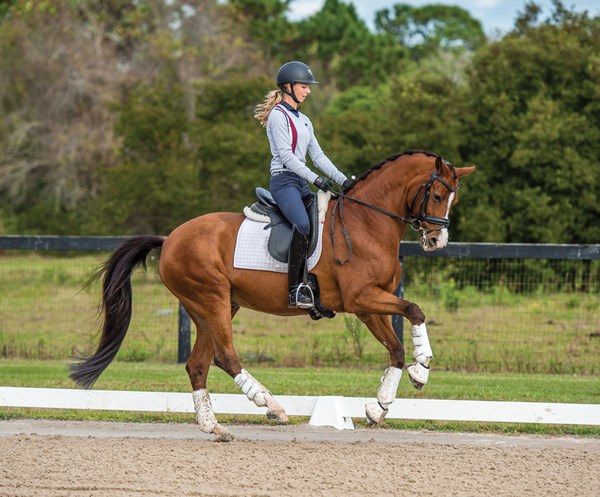
Your goal should be for your horse to maintain forward momentum at all times, no matter what gait he’s in. For example, if he can’t stay in the canter without constant reminders from your leg, you can’t ask for a flying change or any other more technical movement in the canter. Here, Tornado, a Grand Prix-level 14-year-old Dutch Warmblood owned by Katherine Schwartz, is demonstrating an excellent flying change. His engaged hindquarters and relaxed expression show that he has plenty of energy on hand, so the change is easy to achieve. | Amy K. Dragoo
It All Starts with Rhythm
That quality starts at the base of the Training Scale with rhythm, something that all self-going horses possess and upon which all other development is built. The word “rhythm” is defined as a movement or procedure with uniform or patterned recurrence of a beat. Imagine that each stride a horse trots, he is begging to walk while the rider is begging him to keep trotting. The constant debate makes it impossible to sustain a uniform two-beat rhythm. How could you ever passage if you have to kick every stride just to trot?
Maintaining a good rhythm allows us to use our bodies to change the shape of the gait. If a horse is in a self-going canter, I can use half-halts through my body to change how he canters. Do I want him to canter on the spot? Extend the canter? Do a flying change? All of these things are possible only if I can count on my horse to stay cantering. The same is true with every other dressage movement.
The Ubiquitous Rubber-Band Exercise
The best way to test if your horse is self-going and to make him more so is with the rubber-band or accordion exercise. Almost every trainer teaches it, but most people don’t practice it enough. The goal is to ask your horse simply to go forward and back either between gaits or within a gait while maintaining relaxation and connection in the bridle. By doing this during both the upward and downward transitions, he proves that he is truly engaged and through—connected and supple from his hindquarters over his topline to the bit.
This exercise sounds simple, but if it were so easy to do effectively, everybody wouldn’t be working so hard in the saddle. The recipe for success—and for transferring this lesson into all of your other work—combines many important ingredients. First and foremost, your horse must be comfortable in his body. Ensure that he is receiving thorough, routine veterinary care and that all of his tack—saddle, bridle, bit, etc.—fits comfortably.
Next, you must be relaxed in the saddle. One of the biggest confusions I see riders experience is striving for quiet hands but instead becoming too holding and restrictive with the reins. This, in turn, creates tension in the horse and discourages his forward movement. Similarly, many riders don’t realize how tight they are in their upper thighs, which can feel restrictive to horses. So check that you are relaxed in your seat and upper thighs and keeping a soft, following feel of the reins. Finding a trainer who will help you develop these skills on a longe line is paramount.
Also evaluate your aids. Giving them effectively is all about timing. Don’t let technical talk about coordinating your leg aids to particular footfalls intimidate you. Start with this simple rule: Wait for the right moment to make a change. Say you’re schooling at home and planning to pick up the canter at B, but your horse’s head is in the air and he’s trying to run off with you. Instead of asking for the transition where you planned to, wait for a moment when he’s in a better shape and listening to you. As the saying goes, practice doesn’t always make perfect; perfect practice makes perfect.
At least once a week, ride your horse without whips, spurs or, if you use one, a double bridle. This is the best way to ensure that you’re communicating properly with your natural aids and not overly relying on artificial ones.
Once your horse is listening to your aids and maintaining the gait you want, always use the same leg aids—with the same placement and amount of pressure—so he knows exactly what you expect him to respond to. Every rider’s ideal aids are different. I like my horses to be extremely electric. If you put your hand against my leg, you probably wouldn’t even feel the tiny amount of pressure I apply to ask for a walk–trot transition on any level of horse. Many riders might not be comfortable on a horse who is so sensitive to the leg. You must decide what feels like an ideal aid to you and then teach your horse to respond to that same aid every time.
Working Trot to Medium Trot to Collected Trot
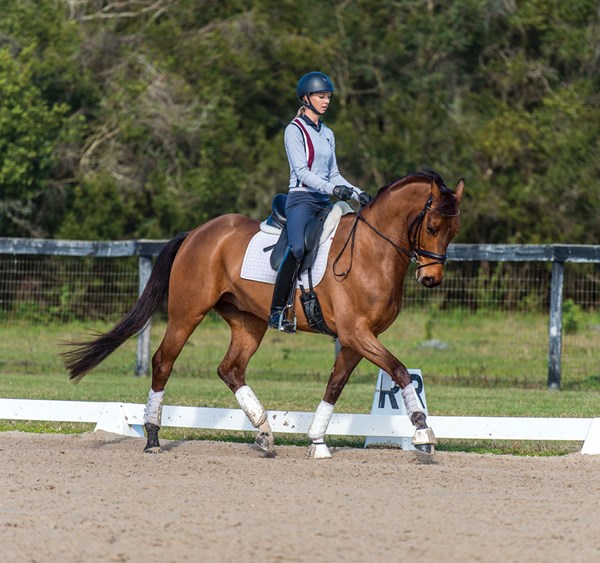
1. A great test of a self-going horse is transitions. If he’s listening to your aids, he’ll make transitions smoothly without losing his balance, popping his head in the air or interrupting the flow. Here I am riding Fizau, a 6-year-old Westfalen who competes at Second/Third Level and is owned by Susan Shattuck. I ask Fizau to stretch and compress his frame like a rubber band. We start down the long side of the arena in a forward working trot. | Amy K. Dragoo
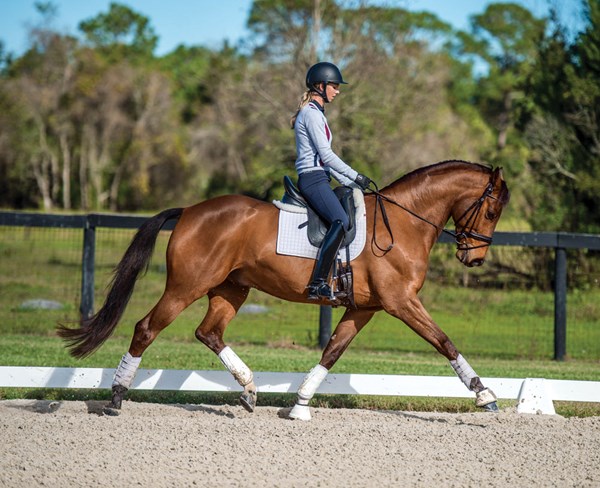
2. Then I ask him to stretch his frame out for a few strides of medium trot. Notice how he is doing all the work here? It’s not my job to create and maintain this trot—I merely give him the cue to make the transition, then sit in the middle of the saddle and keep a steady feel on the reins to help him recycle the energy. Before making a downward transition, I touch him with my legs to remind him to engage his hindquarters. | Amy K. Dragoo
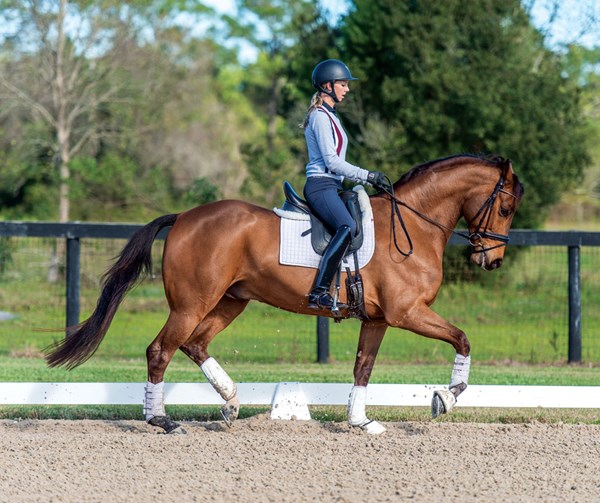
3. I allow him to take a few steps of working trot before asking him to compress his frame even further into a collected trot. Again, his engaged hindquarters and obedient, supple connection show that he’s responding well to my aids and continuing to produce the energy required for this brief taste of collected work. | Amy K. Dragoo
Forward, Not Fast
Another important concept to understand is that forward is not a speed. Think of driving a car. Going more forward is having more power, or RPMs. Going faster is increasing your miles per hour. Warming up a lazy horse by trotting really fast and galloping laps around the ring won’t actually get him forward and in front of your leg. On the other hand, a naturally hot horse can also fool you by being fast but still behind your leg. Most riders tend to avoid using their legs on sensitive horses, even if they’re slow to respond to them, for fear of winding them up more. This can totally backfire to the point where the horse doesn’t respond to your leg aids at all or explodes when you are forced to use your leg, for example, to ask for an upward transition.
One of the moments in the rubber-band exercise that many riders underappreciate is the downward transition. When you ask your horse to slow down, it’s essential that he not stall out, losing the power in his engine and dropping the contact with your hands. To remind my horses to stay engaged and keep coming to the bit during downward transitions, I touch them with my legs before applying my rein aids.
To help your horse maintain the gait and speed you choose, hear the rhythm in your head. Instead of counting, which creates a sense of urgency, I like to imagine listening to music that matches the tempo of my horse’s gaits. Or I mentally repeat words, such as “trot, trot, trot, trot,” in rhythm with his footsteps. To maintain the rhythm and tempo as you ask for upward and downward transitions within the gait, hear the music or words in your head get louder or softer, but always in the same rhythm: “trot, trot, trot, trot, trot, trot …”
The more you practice the rubber-band exercise correctly, the more self-going your horse will become. Use it frequently to test his responsiveness. Get creative. If you have a lazy horse, incorporate the exercise into his warm-up while you’re walking on a long rein. Then when you shorten the reins, try the exercise again. You’ll find that when your contact is shorter, he needs more strength behind—which takes time to develop—to stay engaged during the downward transitions.
Retraining a horse who is not self-going is more challenging than teaching a young horse this concept from the very beginning of his training. But persevere. It’s never too late to experience that wonderful lightbulb moment—and to enjoy the magical rides it produces.
Passage to Piaffe to Passage
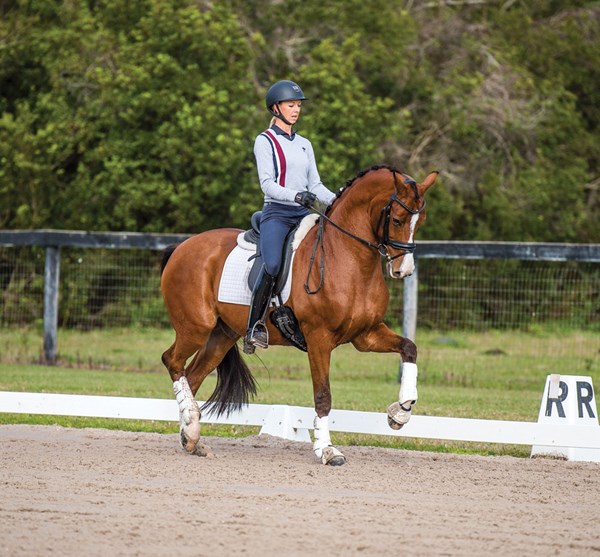
1. The concept is the same with an upper-level horse, only with much more demanding movements. I ask Tornado to begin the exercise with a few steps of passage. | Amy K. Dragoo
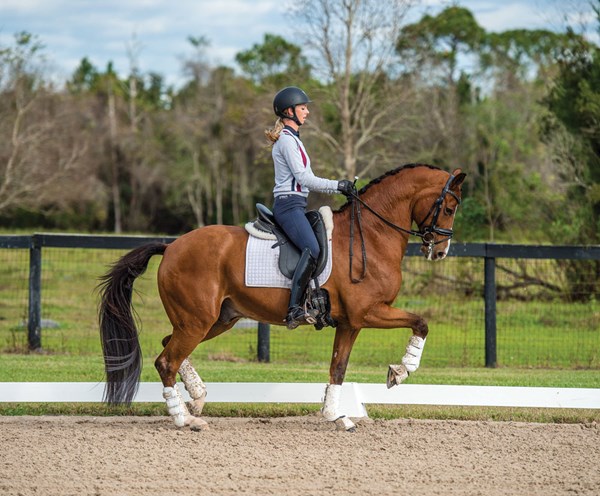
2. Then I ask for a transition to piaffe. He carries the forward momentum from the passage into this more collected movement, channeling the energy upward through his knees and hocks. This calls for a great deal of strength but—once again—he’s the one doing the work, not me. | Amy K. Dragoo
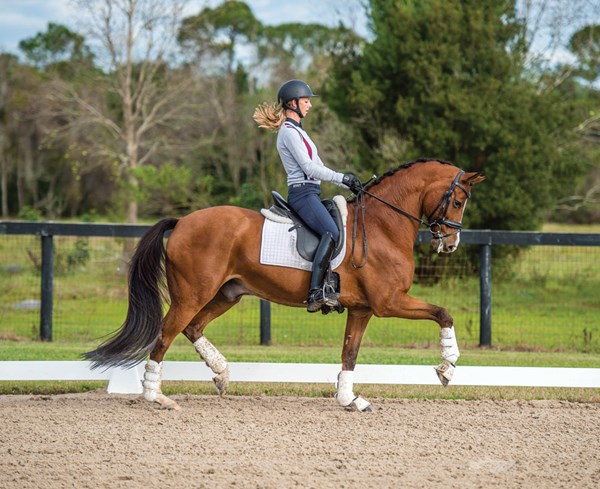
3. We then make another transition to passage, stretching the rubber band back out a little. Tornado’s happy expression shows that he has plenty of energy to produce this movement, too, and is willing to respond to my extremely light cues. | Amy K. Dragoo
The Right Mind-set
One critical ingredient in creating the self-going horse is for both of you to show up to work. From the time I put my foot in the stirrup, my horses know that they are working. I try to make their training sessions fun and rewarding, but I’m also clear that the work will get done. For example, if I’m riding a lazy horse, I don’t allow him to dillydally during walk breaks. I keep him marching along so he’s ready to get back to work the moment I pick up my reins again.
To keep work fun for your horse, approach every challenge with an encouraging “Try this, it’s not that hard” attitude, rather than a more demanding “Do this, do this, do this” attitude. Give plenty of praise when he gets it right. Many horses feel proud when they know they’ve made you happy. Doing something right gives them a little ego boost.
Whatever level you are, think like a trainer. The goal of all training is to strengthen your horse’s weaknesses. Try to identify his strengths and weaknesses objectively and fairly. Treat all horses as individuals. Don’t think of a horse who is too quick in his trot as inferior to a horse with more natural cadence. Later in his career, that quickness may actually make learning the piaffe easier for him than for a slower, more cadenced horse.
If you ride only one horse it can be difficult to stay objective. Some days you may get frustrated and think, “Why isn’t he any better today than he was yesterday?” Remember that progress isn’t always linear. Step back, leave your emotions out of it, and look at his progress over time rather than day to day. It’s probably better than you realize.
Most importantly, don’t punish your horse for making honest mistakes. Good training is as much about us respecting the horse as it is about the horse respecting us. Every horse will struggle at times, and we must make an effort to understand the difference between struggling and defiance. Horses know when they make mistakes. They worry when they can’t help making them because they don’t have the strength yet to do the job right. I forgive mistakes I call “within the realm of right answers”: responses that might not be perfect but are acceptable for that particular horse’s level of training. For example, if I ask my young horse to trot more forward and he accidentally canters, although I am quick to correct him and bring him back to the trot, I am equally quick to praise him for his response. By rewarding his effort, I create a partner who is always willing to try.
Medium Canter to Working Canter
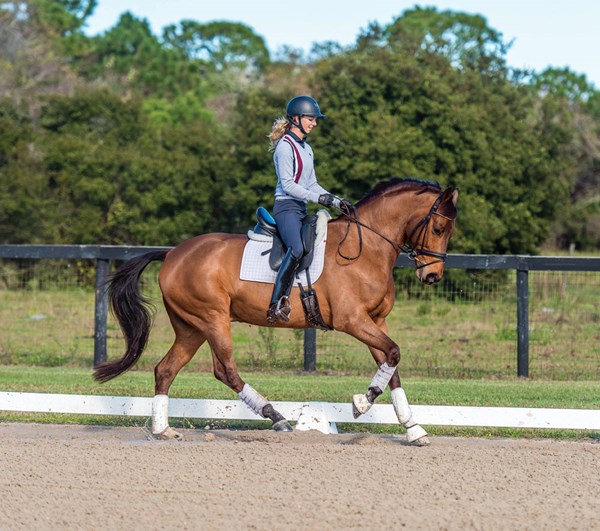
1. I ask Fizau to stretch and compress his frame in the canter, too. Here, he’s produced a nice medium canter. You can see his hind leg reaching well underneath his body to produce a big stride. Notice that I’m maintaining a steady rein connection, being sure that he doesn’t lose his rhythm or balance. | Amy K. Dragoo
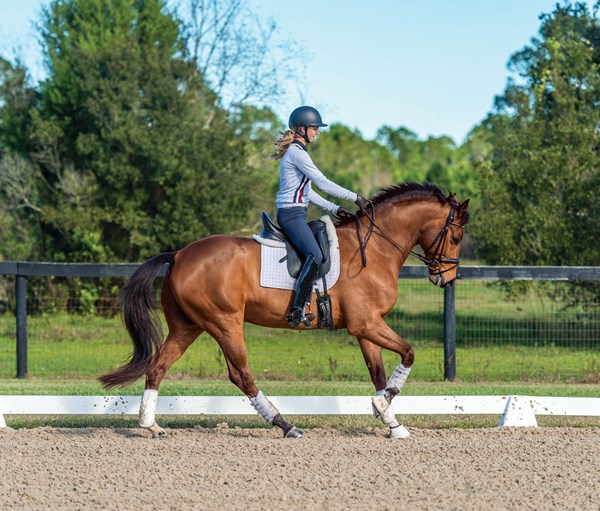
2. After we transition back to working canter, I test that Fizau isn’t relying on my reins for balance. I reach my inside hand forward, giving the rein a little slack. Notice how he’s still in a lovely, supple frame? This proves that he’s carrying himself. | Amy K. Dragoo
Fast vs. Forward
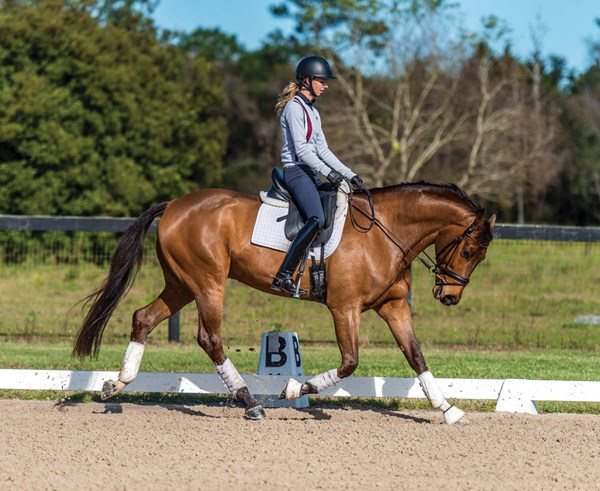
1. Here’s an example of how fast and forward aren’t the same thing. Fizau has plenty of pace here, but his body appears to be moving downhill—his haunches are higher than his withers—and he’s leaning on the reins. He’s lost his nice, balanced self-carriage. To correct that, I use my legs and seat to engage his hindquarters and ask him to shift his balance up and back. | Amy K. Dragoo
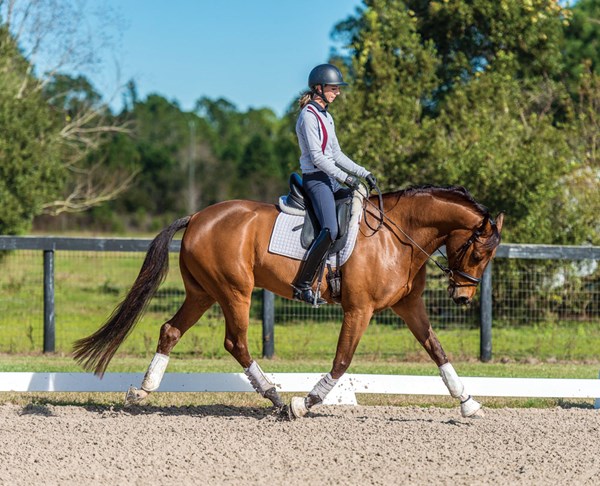
2. Success! Fizau is engaged and carrying himself again. I’m still allowing him to stretch over his topline, but notice that now he isn’t leaning on the reins and his withers are level with his haunches again. | Amy K. Dragoo
In her first year competing at the Grand Prix level, Laura Graves (pictured right on Verdades) wowed the dressage world by earning a spot on the U.S. team for the 2014 World Equestrian Games, at which her team finished fourth and she placed eighth in the Special and fifth in the Freestyle individually. Just one year later, she won the team gold and individual silver medals at the Pan American Games in Toronto. To many, it may have seemed that Laura, 28, burst on the scene out of nowhere, but this was the culmination of years of hard work, training and innovative horse hunting. She and her sisters grew up riding bareback in their Vermont backyard, first on two ponies their mother traded for an old washer/dryer and then on a variety of free horses the family accumulated over the years. Laura’s early interest was less focused on taking lessons and more on preparing horses for 4-H in-hand presentations: washing and trimming the horses, cleaning tack, etc.
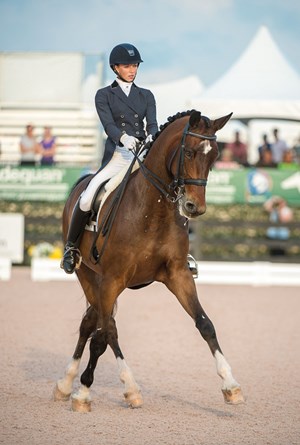
Amy K. Dragoo
When Laura was 11, her parents bought her a small, green, 4-year-old Quarter Horse gelding, Koko’s Eternal Sun, or “Sunny,” who turned out to excel in both jumping and dressage. After she and Sunny finished second at Lendon Gray’s first annual Northeast Junior Young Rider Championships, Laura decided to focus on dressage. She trained Sunny to Fourth Level and earned her U.S. Dressage Federation bronze medal with him.
In 2002, Laura’s mother picked out a Dutch Warmblood foal from a European sales video. The family decided to import him as a weanling. This was Verdades, or “Diddy,” Laura’s eventual WEG and Pan Am Games partner (to read more about him, go to www.PracticalHorsemanMag.com). She broke Diddy herself and brought him up through the levels. Meanwhile, she attended cosmetology school and then found jobs in a salon and a clothing store.
It wasn’t until a trainer suggested that Diddy had international potential that Laura decided to focus seriously on her riding. In 2009, she moved to Florida to train as a working student with 1995 Pan American Games team silver medalist Anne Gribbons. Three years later, she and Diddy reached the Prix St. Georges and Intermediaire I levels. At that point, after waitressing and working other night jobs to support her riding career, Laura decided to start her own training business, CrossTies LLC, based in Geneva, Florida. Her longtime boyfriend, Curt Maes, helped her start up the business and volunteered to keep the barn running when she traveled.
Now a USDF gold medalist, Laura teaches and trains while continuing to polish Diddy’s Grand Prix skills under the guidance of 2004 Olympic team bronze medalist and USEF Developing Dressage Coach Debbie McDonald.
Laura and Verdades were named to the 2016 U.S. Olympic dressage team after successfully competing in Europe this spring. She was a member of the U.S. teams that won the FEI Nations’ Cup at the CDIO***** in Compiègne, France, in May, and placed second in the Nations’ Cup at the CDIO***** in Rotterdam, The Netherlands, in June, where she also won the Grand Prix Special. Earlier this year, she was a member of the winning Nations’ Cup team at the CDIO*** at Stillpoint Farm, in Wellington, Florida. There she also earned a facility record-breaking score of 82.800 percent in the Grand Prix Freestyle.
This article originally appeared in the September 2016 issue of Practical Horseman.










